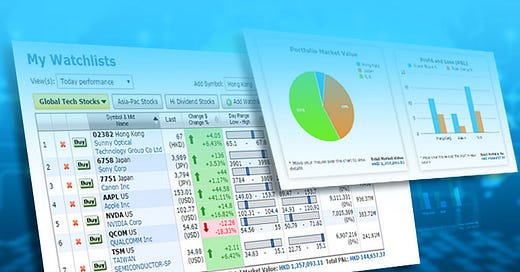Full Course: How to Analyze a Company Series
In my previous 4-part series, we discussed How to analyze a company and its financial statements. In case you missed it, here are the articles in the series:
In this article, I’ll guide you on how to identify exceptional companies, so you can focus your time and effort on analyzing their potential..
The answer is about 56,000 stocks are publicly listed on stock markets worldwide. The New York Stock Exchange (NYSE) and Nasdaq are among the largest stock exchanges globally, with a combined listing of over 5,000 companies.
And it is impossible to look at and understand all the companies.
Building your watchlist
First Step: What type of investor are you?
Before we dive into the details, you need to understand what type of investor you are. Every Investor is unique with different goals.
Value Investor: Buying undervalued companies with good fundamentals.
Growth Investor: Buying companies that have future high-growth prospects.
Quality Investor: Buying companies that have already won as leaders in their business.
Dividend Investor: Buying companies that provide a constant stream of income.
etc
Based on what your investing style is, you need to create watch list criteria accordingly.
My investing style is Quality Investing, so finding Quality companies and waiting for the right value to purchase them.
Second Step: Circle of competence
There are 100’s of business models and industries to chose from but I strongly recommened to focus your investments on industries, businesses, and sectors that you deeply understand.
Personally, I do not understand commodoties, banking, pharma & bitcoin. So I do not invest in them. That does not mean I completely ignore those industries forever. Expanding your circle of competence is possible, but it requires deliberate learning and patience. Investing outside of it often leads to mistakes because you cannot properly assess risks and opportunities.
The size of the circle does not matter, Knowing boundaries does.
Third Step: Financial Stability & Moat of the company
I would focus on companies that are already successful. What I mean by successful is that companies that are already:
Profitable
Revenue- steady growth over the last 7-10 years.
Healthy balance sheets
low debt to EBIDTA margin
Interest coverage > 12X
Liabilities increasing in line with Assets
Retained earnings increasing over time
Low Capex
Positive and growing Free cash flow, Gross & profit margins
High return on Invested capital
Fourth Step: Setting up the Screener
I use Finchat.io for my watchlist and to get all the Financial information on a company. It is a great tool to quickly look at all the important financial metrics and historical data.
I use these criteria for my watch list:
Countries: I chose countries where there is less geopolitical risk
Revenue 10-year CAGR> 7%
Net profit margin> 15%
EPS 5-year CAGR >10%
OCF/NetIncome > 1
Return on Invested Capital> 20%
Net Debt/EBITDA <2
This will give us a total of 149 companies!
This is great! we started with over 55K stocks and drilled it down in just 149 companies! Remember - based on your investing style please update the filters accordingly.
150 companies is still a big number of companies to start with. So I prefer to increase my quality metrics further to start with the best of the best companies in the world. I updated my metrics to the following:
Countries: Same as above
Revenue 10-year CAGR> 12%
Net profit margin> 20%
EPS 5-year CAGR >10%
OCF/NetIncome > 1
Return on Invested Capital> 25%
Net Debt/EBITDA <1.2
This gets us down to ~50 best-run companies in the world!
With these filters, you end up with companies like Evolution AB, Copart, Lam Research, Arista Networks, etc
Fifth Step: Analyzing the companies
Analyzing the best companies will help us learn a couple of things:
Focus on the quality
Learn how the best companies in the world operate
What are the business models of these companies that made them to be successful
How do they have MOAT?
Do they have pricing power?
Management’s primary duty is “Capital Allocation”, how well are they doing
Are they Monopolies/oligopolies?
Learning from the best companies will help us to better analyze companies as we go down the top 50 in the list. Additionally, I am pretty confident that on average these top 50 companies will do better in the next decade.
Conclusion
That’s it for today!
A few things to remember:
Every Investor is different; understand your goals and find companies by adjusting the filters
The size of the circle does not matter, Knowing boundaries does.
When researching a company, do not forget to research the industry and competitors to better understand why the company you are interested in better than others
When analyzing a company, come up with all the ways you want to say no to investing in that company. That’ll help you answer all the questions. Even after that, if you are interested in the company then you can confidently move ahead
Listen to their previous quaterly/annual earnings call to understand recent developments
About Me
I am a self-taught investor who has read hundreds of books on investing and spends 40+ hours a week researching and analyzing stocks.
I did not come from a finance background, and it took me nearly 10 years from first learning about the stock market to finally making my first investment. Since tracking my performance, I have achieved a 40% compound annual growth rate (CAGR).
I created this platform to share my investing journey and help others navigate the stock market with confidence.
Let’s grow together. 🚀
Visit my page to access previous posts.
Disclaimer: This post is for educational purposes only and should not be considered financial advice. Always do your research before making investment decisions.








These are great tips for identifying good companies! Any advice on spotting ones that are both high-quality and undervalued? That’s where I struggle the most :)